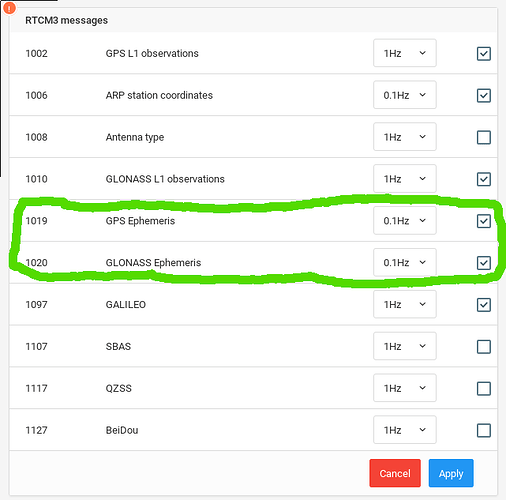We hope to use the Reach system for real-time GIS map making so the need for absolute accuracy makes this a concern.
Something I’ve noticed in RTKLIB on a Windows computer, is that the rtknavi.ini file caches satellite ephemeris data at the bottom of the file. I found this after getting some really bad results from some sample sets. I was finally able to track down the problem after spending a lot of time investigating the various streams in RTKMONITOR. The GNSS rover chip was piping over fresh observables but not fresh ephemeris data. The RTK base was piping over fresh observable.
Normally in this condition the compute logic (whether RTKLIB or “on-chip”) would simply not be able to calculate a solution of any kind because the ephemeris data is absolutely needed. But I found that RTKLIB extracted the weeks-old ephemeris data from rtknavi.ini file and computed a REALLY REALLY bad solution. This is a very worrying problem because the data collector in the field will likely not notice this and unknowingly record the data thinking it’s good when actually it’s very bad.
Not sure why this would happen, but my theory is that the GNSS Rover may be in a satellite reception area good enough to receive observation data but not good enough to receive good ephemeris data. I’ve read that satellites broadcast ephemeris every 30 seconds and it takes 18-20 second to download the whole thing. If that is true a temporary but consistent reception outage between the rover a satellite every 30 seconds could create a situation where observation data is received but ephemeris data is not.
I believe “on-chip” type systems invalidate the ephemeris data after 20-30 minutes. I’ve seen some systems allow you to select special modes that save the ephemeris data for up to 45 minutes. This is for the purposes of working under tree canopies. You power the system on in clear sky and wait 5-10 minutes. Then you go under the tree canopy and collect. Again I assume the tree canopy allows the smaller observation data to get through but not the larger ephemeris data.
Since ReachView is based on RTKLIB, does anyone how long ReachView will cache ephemeris data? Is there any aging logic? Since I can’t access the rtknavi.ini file my workaround does not work with ReachView. is anyone aware of another workaround.





